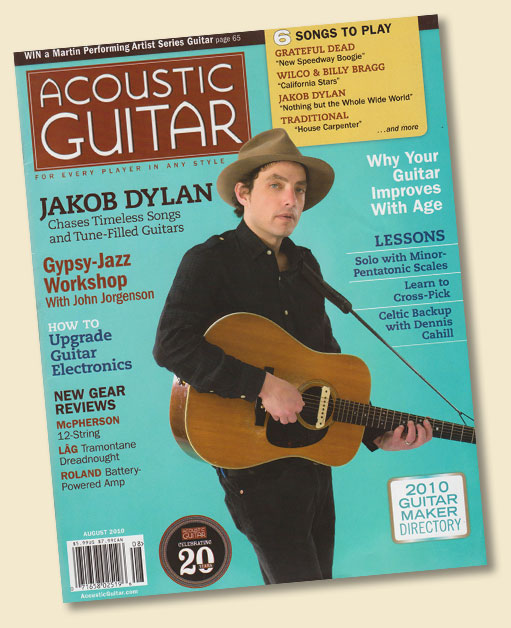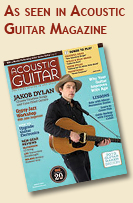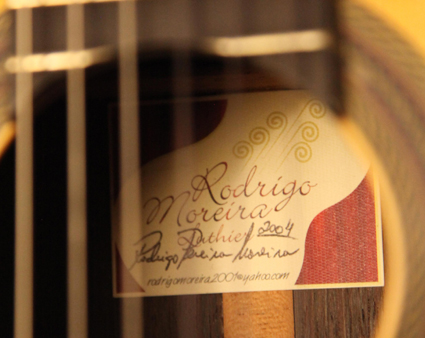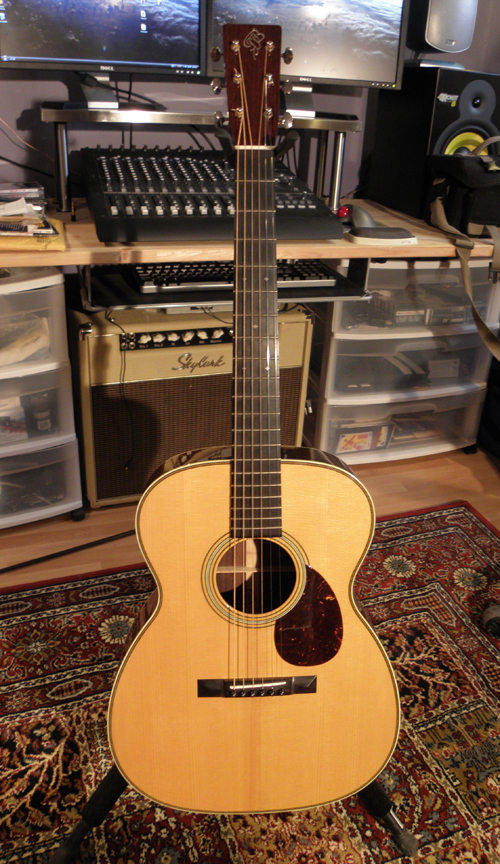Despite the lack of official news, or updates – AAL continues to work with guitar-makers and players, using the AO1 process to bring out the best their instruments have to offer. We’ve been busy behind the scenes and working on private projects and new developments. This has kept up from actively participating in our online conversations. Check in for updates. We are still accepting individual instruments. Please check the Ordering page for information.
NAMM Week Update: AAL Releases AO1 Process Details & New Products For 2011
January 14th, 2011PITTSBURGH, – Alchemy acoustic Labs, LLC (AAL) has made optimizing acoustic instruments their top priority since 2007. In addition to having applied their proprietary AO1 process to a great number of pre-existing acoustic instruments with a 100% success rate since launching the service, AAL has continually pursued new routes to acoustic instrument optimization. In 2010, AAL expanded their AO1 process to the mandolin and violin markets. In 2011 they will release more results of those efforts as well as a more thorough discussion of the process itself.
With information gained by their experience and research on the AO1 process, inventor Frank Sanns has now developed a physical device that will greatly enhance the tonal and response properties of acoustic instruments and give luthiers more design freedom when designing and building their instruments. The new device is patent-pending and will be available both as a standalone, aftermarket accessory and as an integral component on new instruments. AAL has begun collaborative work with key artists & manufacturers in the acoustic instrument market. Plans to unveil private and licensable prototypes will roll-out in the second quarter of 2011.
This month, in response growing interest in their efforts, AAL has released a new level of details about their proprietary, patent-applied-for AO1 acoustic optimization service via their website, https://alchemyacousticlabs.com.
After an instrument arrives at AAL, the AO1 Process begins by a thorough visual inspection followed by sonic and tactile impressions made by one or more guitar techs and/or players.
After the initial evaluation is completed, the instrument is placed in an anechoic chamber and a proprietary sensor system maps the input and output response of the primary sound forming surfaces of the instrument. The I/O response is then used to establish unique process parameters that will be implemented on each individual instrument. Just as no two instruments are the same, the AO1 process is custom calibrated for every instrument.
Once the process parameters are mapped, various locations of the instrument are targeted and then are non-thermally annealed by focusing high energy sonic waves of extremely specific energy levels at corresponding specific locations on the instrument while response measurements are tracked simultaneously.
The AO1 process allows for symmetrical, properly located oscillations to occur in the sound-forming surfaces of the instrument and manifests itself in greater volume/dynamic range, richer, more full sound, and greater responsiveness to the player’s touch. Over the course of the following 4-6 weeks, the instrument will continue to transform to its full 100% potential assisted by frequent playing.
AAL has processed instruments for multiple large-scale manufacturers and modified versions of the AO1 process are available for manufacturer’s licensing.
AAL in Acoustic Guitar Magazine
July 20th, 2010 AAL was mentioned in a sidebar to a great article about guitar aging by Robert Johnston in the August issue of Acoustic Guitar Magazine.
AAL was mentioned in a sidebar to a great article about guitar aging by Robert Johnston in the August issue of Acoustic Guitar Magazine.
We bring this up not so much as a promotional vehicle for us (don’t get me wrong, we’d work it if we could find a way, but it was only a name drop, not a cover story!) as much as to point out a well-structured bit of journalism about a topic near and dear to our hearts here. The article discusses the properties of aging that directly contribute to the changing of an acoustic guitar’s sound.
A quote from the article:
“There is no question that stringed instruments change as they’re aging and are getting played. On some instruments, the changes people detect are dramatic, while on others they’re more subtle, making it difficult to predict the sound a new guitar will deliver in the future. For these reasons, it’s best to not count on specific tonal improvements when purchasing a new guitar, but rather to choose one that sounds great to you now; think of anything else as icing on the cake!”
Which is a seemingly obvious yet, surprisingly crucial statement that we firmly support. What we’ve said about our process from the beginning, that it’s YOUR guitar, only moreso – is still behind everything we do. We wouldn’t have the level of customer satisfaction that we do now (100% by the way) if we made people’s guitars sound like other guitars. You picked your guitar out with emotion and great care. What we do is to take your guitar to ITS fullest potential. Not make it sound like something it wasn’t meant to be, but rather exactly what it WAS designed to be, someday in the future.
We’re happy just being mentioned in the article, even if it is in the same breath as a couple device-based gizmos that throw a wacky one-size-fits-all, “Flowbee” shroud over the science of what we do. (It’s okay, we understand. $149 is hard to pass up. We’re not saying they don’t work, in um – their own way. Talk to us about it sometime.)
One thing the article talks about that we wish we had the chance to respond to formally is this notion that even in the best lab testing they’ve devised, these are super-subtle effects that human auditory memory can’t even discern between because ear memory dissipates so quickly – yadda, yadda. Um, respectfully – no. Maybe if you’re trying to compare two “same” guitars (note – the author does allow that no two guitars are ever truly the same, but they still used the reports from the test) or sticking an aquariam vibrator on your guitar for a 100 hours, or just asking unassociated players which guitar tone they like better – you’ll get some varying results that could be attributed to the poor human ear memory. But we haven’t had one customer yet report back anything less than dramatic transformation in volume, balance, sustain etc. from our process. In fact, it’s been blogged about independently out in the world. More importantly, we’ve captured and graphed those unsubtle differences with our data measuring equipment. let me go further and add what we’ve said all along – if any notable publication (like AGM, for example) wants AAL to put our money where our mouths are – we’ll process a guitar for free for their scrutiny, or take part in a test or shootout.
Let’s talk.
Rodgrigo Moreira Hauser Replica
July 20th, 2010Frank brings the freshly AO1-optimized Rodrigo Moreira Hauser replica classical guitar back to Porsche specialist John Raysich, at his repair shop (John Raysich Porsche Specialties) in Pittsburgh, PA.
This guitar has an interesting story. Moreira was commissioned to do some restoration work on Segovia’s 1931 Hauser I guitar. Having one, if not THE most prized classical guitars in the world in hand, Moreira decided to build a replica or two….
It’s February, which was pretty brutal this year in Pittsburgh, and John was busy at work, in coveralls, with beepers and phones ringing and mechanics asking him questions while he tried the guitar for the first time after being processed. So – as usual, we present a very candid, un-glamorous look at REAL customers’ REAL reactions when they get their instruments back.
Elambo’s Julius Borges OM-28
May 8th, 2010We offered to do one guitar for one member of the online Collings Forum community free of charge. The recipient selection process took some time, but in the end we decided to go with one of the moderator’s guitars. Elambo is an audio engineer, studio musician and the furthest thing from an AAL cheerleader we could find. We wanted an objective opinion. We’re posting our results and opinions before Elambo does, in an effort to be as forthright as possible. Let the chips fall.
The Julius Borges OM-28 was one of our favorite guitars we’ve ever played or had in our labs. The build quality and playability is just phenomenal. It was already optimized for volume, versatility and projection by design when we received it.
Post AO1 process, it did not come up as dramatically in amplitude (volume) as some other guitars we’ve processed. It had more increase in sustain than volume. But where we felt that the process enhanced its sound the most was in the evening out of the notes, filling in the bottom end in the lows and low-mid ranges. It truly opened up the guitar in the way that age and playing (a lot) would do.
We’ll post updates to this guitar as the story continues to unfold. For now, here are some audio and video files chronicling the event.
Audio Files:
Elambo’s Borges (Before A01 Process 01)
Audio clip: Adobe Flash Player (version 9 or above) is required to play this audio clip. Download the latest version here. You also need to have JavaScript enabled in your browser.
Elambo’s Borges (After A01 Process 01)
Audio clip: Adobe Flash Player (version 9 or above) is required to play this audio clip. Download the latest version here. You also need to have JavaScript enabled in your browser.
Elambo’s Borges (Before A01 Process 02)
Audio clip: Adobe Flash Player (version 9 or above) is required to play this audio clip. Download the latest version here. You also need to have JavaScript enabled in your browser.
Elambo’s Borges (After A01 Process 02)
Audio clip: Adobe Flash Player (version 9 or above) is required to play this audio clip. Download the latest version here. You also need to have JavaScript enabled in your browser.




